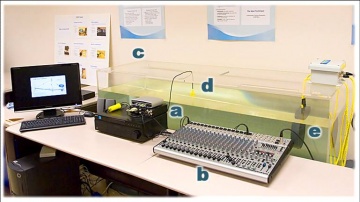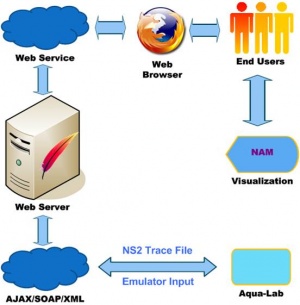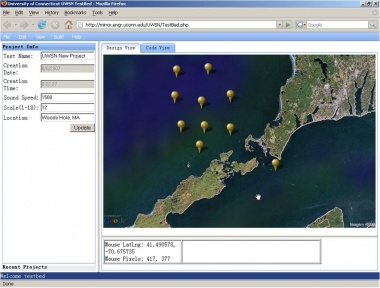Aqua-Lab
Contents
Overview
Aqua-Lab aims to provide field test experience in lab controlled environment. The main advantages of Aqua-Lab include providing real channel environment and being configurable, controllable, accessible and affordable.
Motivation
Field test and simulation are the two major approaches to test the performance of underwater network protocols. However, both of them have some limitations. The limitations of filed test include high cost and time consumption. On the other hand, pure simulation usually fails to realize real environment parameters and an accurate underwater model. In order to conquer these limitations, we designed Aqua-Lab, a powerful lab testbed.
System Components
Aqua-Lab is composed of two parts: Aqua-Lab itself which includes hardware environment, software library and software emulator; Graphical User Interface which is a web-based GUI and utilizes modular design to improve extendability.
Design
Aqua-Lab Hardware
a Micro-Modem: Work with Transducers (Hydrophone & Speaker)
b Sound Mixer: Introduce Multiple Acoustic Signals
c Water Tank: Underwater Environment
d Hydrophone: Receiver
e Speaker: Transmitter
Aqua-Lab Software
The software of Aqua-Lab includes three parts: Low-Level Library, High-Level Library and Emulator. Low-Level Library is responsible for interacting with modem and is transparent to users. High-Level Library is built upon Low-Level Library and provides Socket-Like programming interface. Emulator provides interfaces to emulate complex topology, propagation delay and attenuation.
Graphical User Interface
To be user friendly, Aqua-Lab provides a web-based graphical user interface, which allows end users to interact with Aqua-Lab without any difficulties. The first figure below illustrates the GUI model of Aqua-Lab. The GUI is written in PHP/XML/Javascript Ajax and uses dojotoolkit as AJAX library. The second figure below is a snapshot of the Graphical User Interface.
People
- Zheng Peng, Assistant Professor, Computer Science Department, Grove School of Engineering, City College, City University of New York
- Haining Mo, Oracle
- Jun-Hong Cui, Professor, Computer Science & Technology, Jilin University
Publications
- Aqua-Net: An Underwater Sensor Network Architecture: Design, Implementation, and Initial Testing, Zheng Peng, Zhong Zhou, Jun-Hong Cui and Zhijie Jerry Shi IEEE/MTS OCEANS, 2009
Sponsor
This project is supported in part by the US National Science Foundation under CAREER Grant No. 0644190, Grant No. 0709005, Grant No. 0721834, Grant No. 0821597 and the US Office of Navy Research under YIP Grant No. N000140810864.


